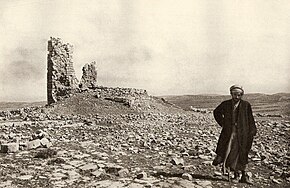Beth-Zur

Ruins of medieval tower at Khirbet Burj as-Sur, biblical Beth-zur, 1920s
|
|
| Location | West Bank |
|---|---|
| Coordinates | 31°35′00″N 35°06′00″E / 31.58333°N 35.1°E |
| Site notes | |
| Archaeologists | O.R. Sellers |
Beth-Zur (also Beit Tzur, Bethsura) is a biblical site of historic and archaeological importance in the mountains of Hebron in southern Judea, now part of the West Bank. Beth Zur is mentioned several times in the Hebrew Bible and the writings of the Roman Jewish historian Josephus. The Battle of Beth-Zur took place here in 164 BCE.
Beth-Zur has been identified with the site of Khirbet et-Tubeiqa.
The name Beth-Zur means "house of rock", or less likely "house of the god Zur".
Beth-Zur is mentioned in Joshua as being near Halhul and Gedor, in the Judean hill country.Rehoboam is credited with its fortification. The Prophet Nehemiah is said to have been the ruler of a half district of the same name.
O.R. Sellers, excavating at Khirbet et-Tubeiqa in 1957, discovered that the site was first settled at the end of the third millennium BCE, and was fortified, like many other Canaanite cities, during the Middle Bronze Age IIB in the 18th-17th centuries BCE. The settlement continued into the Iron Age, and a rare coin inscribed "the governor Hezekiah" attests to the existence of Beth-Zur during the Persian period.
Betsoura, as the Greeks called the town, reached a peak of prosperity during the Hellenistic period. A citadel was built at Betsoura during the 3rd century BCE, when a series of wars between the Seleucid Empire and the Ptolemaic Kingdom of Egypt rocked the region.
In 164 BC, during the Maccabean wars, the Battle of Beth-Zur was fought here. The site’s importance lay in its strategic location on a hilltop dominating the highway, preventing the approach of a hostile army from the Valley of Elah to the Judean plateau. Josephus describes Beth-Zur as the mightiest stronghold in Judea.
...
Wikipedia

